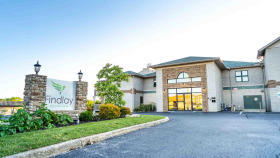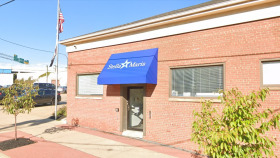Expert Insights
There are 380 Ohio residents in need of treatment for every one provider, according to the Ohio Council of Behavioral Health. Obviously, this doesn’t meet current needs, and it definitely won’t meet future needs. The state must beef up its behavioral health workforce. But there are so many barriers, this is nearly impossible. The first is excessive educational requirements. I have a bachelor’s degree in social work, but I need a master’s to be licensed in Ohio. This limits the earning potential for behavioral health professionals. Ohio needs to update policies to establish better career pathways and competitive compensation to draw workers to this field.
~ Kerry Nenn
How Much Does Drug Rehab Cost in Ohio?
Ohio is ranked 25th nationwide in terms of addiction treatment affordability, with an average cost of drug and alcohol rehab of $56,688 (without insurance).
- Medical detox is the most expensive, with an average cost of $139,757
- Long-term inpatient drug rehab in Ohio costs an average of $50,024
- Outpatient addiction treatment in Ohio costs an average of $8,312
- Outpatient methadone treatment is the most affordable, with an average cost of $7,385
The exact cost of drug or alcohol rehab in Ohio varies widely and depends on several factors:
- Inpatient vs. outpatient
- Where the facility or detox center is located
- Insurance plans accepted
- Amenities and features (luxury vs. standard)
- Length of stay
How to Pay for Drug Rehab in Ohio
As of 2024, there were over 680 drug rehab facilities across the state of Ohio. These facilities accept several payment methods. Of those treatment facilities, the following numbers reflect how many accept their respective payment methods:
There are several ways to pay for addiction treatment centers that go beyond self pay and help reduce your financial expenses. Knowing these options can help you have a productive discussion with the financial counselor at the treatment center of your choice.
Private Pay + Insurance
Private insurance plans are provided by commercial insurance providers rather than government entities. They cover a range of healthcare services, including treatment for substance abuse and mental health conditions. Plans vary widely in terms of your coverage, costs, and benefits.
Some people prefer to pay the cost of rehab out of pocket to retain privacy so their insurance provider is unaware they require addiction treatment. These are some of the major insurance carriers in Ohio.
- Aetna
- Ambetter
- Anthem
- Anthem Blue Cross and Blue Shield
- Buckeye Health- Medicaid managed care
- CareSource – Medicaid managed care
- Cigna
- Humana
- Kaiser Permanente
- Medical Mutual
- Molina Healthcare
- Paramount
- SummaCare
- United Healthcare
Medicaid
Medicaid is a comprehensive package of healthcare coverage that’s funded jointly by the federal and state governments. Ohio Medicaid offers free and low cost coverage when you qualify. Eligibility criteria include income, citizenship, social security number, and a set of physical criteria that can include pregnancy, blindness, an age of 65 and older, or if you have a disability or live with someone with a disability.
Ohio Medicaid is administered through the Ohio Department of Medicaid. After enrollment, you are assigned a Managed Care Organization that may include Buckeye Health or CareSource. Once enrolled, these insurance providers answer questions about coverage and help you find a healthcare provider in your area.
Medicare
Medicare is a federally funded program for people 65 and older or individuals younger than 65 with specific disabilities or health conditions. Medicare has two parts that provide coverage: A and B. Medicare Part A covers inpatient care in hospitals or skilled nursing facilities and Medicare Part B covers outpatient services including doctor’s visits, durable medical equipment, and preventive care services like screenings or vaccines.
Medicare helps cover drug and alcohol addiction treatment during residential or inpatient care and for outpatient programs. The Centers for Medicare and Medicaid Services administers Medicare. You may purchase Medicare Advantage or a Medicare Supplement Plan through a commercial insurance provider to expand the Original Medicare benefits.
Military Insurance
You may be eligible for military health benefits depending on several factors, including the length of time you were on active duty and whether you received an honorable discharge. Ohio residents are eligible for TRICARE, which is a premium-based government insurance plan available worldwide to U.S. military personnel not on active duty.
In Ohio, military personnel, veterans, retirees, and their families may be eligible for OhioCares. This is a collaborative effort between state and local agencies developed to support behavioral health concerns. The partnership identifies local community resources that address mental health and substance use disorders.
Tribal Programs
The Indian Health Service (IHS) divides the U.S. into 12 geographical areas and each has a unique group of tribal members. Grants are awarded by the IHS Office of Clinical and Preventive Services to tribal organizations to combat substance abuse and suicide.
Ohio has received six grants to address tribal issues, such as tracking prescription medication, researching solutions for the opioid crisis, and researching education programs related to substance abuse in the school systems. Tribal members can apply to their governing body for funding to help cover the cost of drug rehab.
Other Low-Cost Options
Several low cost options make addiction treatment more accessible. Personal loans may be the fastest way to receive attention. You can set a repayment schedule tailored to your budget. However, some treatment centers also offer more help.
- Payment program: These may fit within your budget and most do not charge the interest rate that normally accompanies a bank loan.
- Sliding scale fees: Treatment cost is based on your income and ability to pay. It typically requires documented proof of income.
- Grants and scholarships: The Substance Abuse and Mental Health Services Administration (SAMHSA) is one of several agencies that offer grants and scholarships, including, local governments, tribal communities, non-profit organizations, and other community-based groups.
- Faith-based programs: Many people in recovery base their treatment on religious beliefs and values, which offer a significant advantage when they match yours. Financial assistance is often available.
- Crowdfunding: It may be difficult to ask for help publicly, but seeking professional help is a critical step toward a healthier and happier life.
Free Addiction Resources in Ohio
Free rehab centers in Ohio can remove the financial barriers that may stand in the way of getting help for drug and alcohol addiction treatment. Ohio has substance abuse rehab centers that offer free or low cost addiction treatment when you need quality healthcare. Others have higher costs due to the luxuries and amenities featured. Many of these also provide treatment for co-occurring mental health conditions that can complicate recovery.
Free drug rehab can include inpatient and outpatient services that offer individual, group, and family therapies. Drug and alcohol rehab centers may also offer scholarships, payment assistance, and sliding scale fees to help lower financial barriers.
You have several options. They include state funded and government funded programs that make addiction treatment more affordable. They also include state funded coverage like Medicaid or government funded programs like Medicare. State funded programs may not offer the same amenities as private drug rehabs, but they often have the same effective level of healthcare.
Some private alcohol and drug rehab centers will take state or government funded coverage, including Medicaid and Medicare. Let’s explore some of the different ways that you can pay for addiction treatment in Ohio to reduce your financial burden and ensure you receive the care you need to live a sober and productive life.
Several statewide resources in Ohio help reduce your financial burden when you need drug and alcohol addiction treatment.
Integrated Services for Behavioral Health
Integrated Services for Behavioral Health: With multiple addiction treatment centers across southeast Ohio, they provide a variety of services including peer support, housing, and mental health and addiction treatment. Services also include medication for opioid use disorder, peer support, and psychiatry.
Ohio Careline
Ohio Careline: They provide 24/7 emotional support call service. The program was created by the Ohio Department of Mental Health and Addiction Services to help those struggling with a crisis so they have confidential support when they need it. Callers receive immediate assistance and referrals to local providers.
Wexner Medical Center
The Ohio State University Wexner Medical Center: They offer a group of highly trained drug and alcohol addiction treatment for Ohio residents with multiple different drug addictions, including cocaine, alcohol, prescription drugs, methamphetamines, opiates, and more. Experts are dedicated to using evidence based treatment options, including medical detox, residential treatment, outpatient programs, and medication management.
Talbert House
Talbert House provides services at multiple sites that help adults and families live healthy and productive lives through their five service lines including treatment for addiction and mental health conditions. They provide face to face, prevention, and hotline services using an integrated system of care across a wide range of services.
The Centers
The Centers: The Behavioral Health Urgent Care opened in 2022 to provide care for children and adults who need immediate care due to serious mental health symptoms or co-occurring mental health conditions. They also provide medical care, case management, and victim services. Family services include job training, education support, childcare, and parental support.
Ohio Drug Use Statistics

In 2020, 17.7% of adults in Ohio engaged in binge drinking or heavy drinking (national average is 17.6%).1

In 2017, roughly 6% of Ohio residents aged 12 and older experienced alcohol use disorder (AUD).2

Ohio ranked the fifth-highest state for overdose deaths in 2020, at 35.9 deaths per 100,000 people.3

Fentanyl was involved in 76% of all overdose deaths in Ohio, usually in combination with other drugs.4
Important Drug Laws in Ohio
Marijuana Law
The possession, sale, cultivation, and trafficking of cannabis is illegal. Medicinal use is legal and recreational use is illegal but decriminalized. House Bill 523 established the framework for medical use and felony charges are reserved for possession of more than 200 grams.
Controlled Substance Regulations
Ohio state law details how controlled substances may be prescribed and dispensed, including Schedule II, III, and IV drugs. Schedule II drugs include cocaine, meth, hydromorphone, and fentanyl. Schedule III drugs include ketamine, testosterone, and anabolic steroids, and Schedule IV drugs include Valium, Ambien, Tramadol, and Xanax.
Operating a Vehicle Under the Influence
The Legislative Service Commission updates the Code, including the penalties for operating a vehicle under the influence of drugs or alcohol. It establishes legal limits for blood alcohol concentration and imposes penalties for violations, including fines, license suspension, and imprisonment. Repeated offenses result in harsher consequences.
Addiction Discrimination
Ohio laws prohibit discrimination against employers providing reasonable accommodation for drug and alcohol addiction treatment, as long as the length of treatment does not cause hardship to the company. The law covers discrimination based on race, color, religion, sex, military status, national origin, disability, age, or ancestry in employment, housing, public accommodations, and credit. Violations may result in legal consequences, including fines and corrective actions.
Narcan Access
Naloxone can reverse an opioid overdose, blocking the effects of opioids in the brain. Ohio shields prescribers from criminal prosecution for prescribing and distributing naloxone, and they have immunity from civil liability and professional sanctions. The law is broad and shields laypersons and pharmacists from criminal liability but not civil liability.
Resources
- Ohio Population 2020 (Demographics, Maps, Graphs). (n.d.). Worldpopulationreview.com.
- Drug Overdose. (2021). Ohio.gov.
- FindTreatment.gov. (n.d.). FindTreatment.gov.
- America’s Health Rankings. (2021). Trend: Excessive Drinking, Ohio, United States. Analysis of CDC Behavioral Risk Factor Surveillance System. United Health Foundation.
- Substance Abuse and Mental Health Services Administration. (2017). 2016-2017 National Survey on Drug Use and Health National Maps of Prevalence Estimates, by State.
- National Center for Drug Abuse Statistics. (2020). Drug Abuse Statistics.
- Ohio Department of Health. (2019). Violence & Injury Prevention Section: Drug Overdose.
- Pettinati, H. M., & Dundon, W. D. (2011). Comorbid depression and alcohol dependence. Psychiatric Times, 28(6).
- Harvard Medical School. (2007). National Comorbidity Survey (NCS). Data Table 1: Lifetime prevalence DSM-IV/WMH-CIDI disorders by sex and cohort.
- National Institute on Drug Abuse. (2008). Comorbidity: Addiction and Other Mental Illnesses.
- Gielen, N., Havermans, R. C., Tekelenburg, M., & Jansen, A. (2012). Prevalence of post-traumatic stress disorder among patients with substance use disorder: it is higher than clinicians think it is. European Journal of Psychotraumatology, 3, 10.3402/ejpt, v3i0, 17734.
- Walker, M. S., Kaimal, G., Gonzaga, A., Myers-Coffman, K. A., & DeGraba, T. J. (2017). Active-duty military service members’ visual representations of PTSD and TBI in masks. International Journal of Qualitative Studies on Health and Well-Being, 12(1), 1267317.
- Ostacher, M. J., & Sachs, G. S. (2006). Update on bipolar disorder and substance abuse: recent findings and treatment strategies. The Journal of clinical psychiatry, 67(9).
- Goretti, S., Sanchéz, M. D. C. S., Borja, P. L., Rivera, G. B., & Lara, M. R. (2017). The relationship between personality disorders and substance abuse disorders. European Psychiatry, 41(S473-S474).
- Substance Abuse and Mental Health Services Administration. (2013). Family Therapy Can Help.
- U. S. Department of Health and Human Services. (2016). Chapter 6: Health Care Systems and Substance Use Disorders. Substance Abuse and Mental Health Services Administration (US). Office of the Surgeon General (US). Facing Addiction in America: The Surgeon General’s Report on Alcohol, Drugs, and Health.
- Gray, C., & Argaez, C. (2019). Residential Treatment for Substance Use Disorder: A Review of Clinical Effectiveness. Canadian Agency for Drugs and Technologies in Health.




























